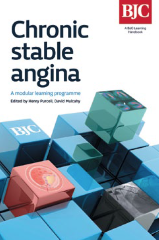www.bjcardio.co.uk/learning
Editors: Mulcahy D, Purcell H
Publisher: Medinews Cardiology Limited, London, 2012
ISBN: 978-0-9573701-0-4
 Coronary heart disease is responsible for one sixth of UK deaths. Improvements in making an earlier diagnosis and more effective management have aided a reduction in mortality over the last two decades. Such improvements would not have been possible without well thought-out and carefully constructed guidance and teaching programmes. With the spread of internet technology, online medical education has seen an exponential growth in popularity. The British Journal of Cardiology (BJC) has recently launched its e-learning site BJC Learning and its first e-learning programme on angina (www.bjcardio.co.uk/learning).
Coronary heart disease is responsible for one sixth of UK deaths. Improvements in making an earlier diagnosis and more effective management have aided a reduction in mortality over the last two decades. Such improvements would not have been possible without well thought-out and carefully constructed guidance and teaching programmes. With the spread of internet technology, online medical education has seen an exponential growth in popularity. The British Journal of Cardiology (BJC) has recently launched its e-learning site BJC Learning and its first e-learning programme on angina (www.bjcardio.co.uk/learning).
The angina e-learning programme is a series of interactive evidence-based learning modules designed to cover all aspects of the condition, from epidemiology, prevention and pathophysiology, through to the most up-to-date diagnostic and management options.
Each module requires approximately one to two hours to complete and one CPD point is given for each hour of learning. The modules are clear and concisely written, making them easy to read. They assume minimal prior knowledge and can therefore be useful towards a wide range of audiences. For example, the diagnosis of angina module includes a wonderful summary of the differential diagnosis of chest pain, detailing pertinent history and examination features used in the diagnostic process. Reading through the paragraphs really reminds us of receiving a well thought-out teaching session from a cardiology consultant. The same module also contains a dedicated section for GPs covering a step-wise approach to patients with chest pain in the clinic.
The wide range of specialist authors is reflected in the comprehensive manner through which different aspects of coronary heart disease are approached, providing not only well-referenced factual information, but also insight into how and why cardiology guidelines evolved.
One of the most striking features we noticed is the resourcefulness of the modules’ illustrations and multimedia. Appreciation for this is especially obvious on the topic of advanced cardiac imaging where no amount of text can replace watching dye running through stenosed arteries, or an impaired ventricle contracting on cardiac magnetic resonance imaging.
Each learning module comes with a certificate upon completion – to obtain it you must pass a test, which comprises of a series of multiple choice questions. Although a few questions seem slightly arbitrary in terms of requiring the reader to recall specific statistics, the tests overall are suitably tailored to the contents of each module, and do well in terms of reinforcing the key learning points. A two-attempt limit on each test also ensured that we remained focused at all times.
An e-learning module series should be assessed on the quality of its contents and how effectively it teaches this information to users. We found the BJC angina modules not only achieved these criteria but were also a joy to read. They are also available free of charge with an accompanying course textbook. To those who wish to learn more about coronary heart disease, we highly recommend using the BJC as a user-friendly one-stop resource for your learning needs.
Boyang Liu
Simiao Liu
Accident and Emergency Medicine Homerton University Hospital, Homerton Row, London, E9 6SR
